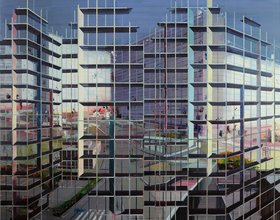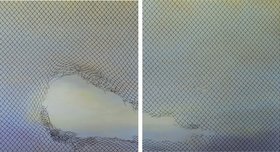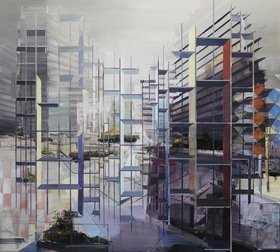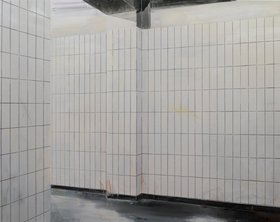Interviews
‘If Walls Could Talk ...’
Driss Ouadahi in conversation with Rachida Triki
Suburban high-rises are an unavoidable sight in cities across the world, their dominance both a statement of affluence and hubris. Algerian artist Driss Ouadahi paints these structures in works that explore the failed legacy of Modernism and the displacement of peoples from countryside to city and from country to country. In this conversation with Ibraaz's Contributing Editor Rachida Triki, Ouadahi discusses a body of work dealing with suburban architecture, and recent paintings depicting chain-link fencing and tiled passageways – in short, the everyday urban language of restriction and control.
Rachida Triki: Could you explain your choice of painting highly realisitic architectural elements that are relatively everyday and at times prosaic?
Driss Ouadahi: You are quite right, these pieces of architecture don't belong to what you could call 'privileged' urban areas; however, as the saying goes: 'If walls could talk'. I would say that that these buildings have a lot to say through their structures and their many layers of memories and the many cultures that have passed by and through them. Over the last ten years, I have painted urban landscapes, tower blocks, car parks, playgrounds, green spaces, all the elements that together make up the suburban space we see in every city. The suburbs (Dans-Cité, literally 'within the city') is a narrow space with a pictorial density that I reflect upon in the paintings. I feel there is a narrative density within the space that speaks to me and this is what I try to convey in my painting.
RT: So what you are painting is a lived experience of the space?
DO: These urban landscape paintings aren't really executed in a realistic manner: the canvas becomes the receptacle for the deposited subject matter which, more so than the matter itself, also collects gestures, rhythms and colours that exist in these spaces. However, I have two other recent groups of paintings that refer to two elements of the urban landscape. One is inspired by metro journeys, which convey for me a sense of claustrophobia or fear of enclosure, further evoked by the walls and the floors being entirely covered by white tiles. The second series depicts a kind of spatial delimitation, signified by railings, which are reminiscent of abstract minimalist painting but which also signify forms of separation. Through these paintings, I try to elaborate upon a language that is both readable and universal, using these architectural elements as a starting point, as well as suggesting the light and atmosphere of these urban areas.
RT: If I understand you correctly, you attribute a sentient nature to these buildings, without betraying their inherent language. Do you think that contemporary painting has the ability to elevate the universal nature of marginalised objects – in this case, the marginalised suburban?
DO: Marginalised objects have often been eminent subjects in modern and contemporary art: think of Édouard Manet, Marcel Duchamp and the Arte Povera artists. With these marginalised urban zones, my choices were based on real architectural elements, omnipresent in their richness and their diversity, which form part of the particular psycho-geography of the space and of the non-space – a form that contains a physical, psychological and conceptual infrastructure that in turn constitutes these urban worlds.
RT: So it's this idea of space and non-space that you are looking for in your painting?
DO: I am particularly interested in placing these spatial and temporal elements within a context that is balanced between representation – recognition of the object – and what is evoked. All the elements painted through the railings let certain structures and pictorial mechanisms appear, allowing for a reading that operates purely within the paintings: it exists autonomously, and will in turn provoke other interpretations.
RT: You have lived in various countries; Morocco, Algeria, France, and currently Germany. Do you think that the diversity of these environments pushed you, in a way, to transcend representation towards a form of purification in the representation of space?
DO: I was born in Casablanca, a city I know only through the wonderful memories of my Algerian parents who lived there for quite a long time. I grew up in Algeria, where I began my first years of academic study at the École supérieure des beaux-arts in Algiers. Later on, and as a result of my trip through France and my studies at the Staatliche Kunstakademie Düsseldorf in Germany, I came to think about giving my painting a purified body, which would reflect my experiences, while constantly exploring my own identity. Therefore, my painting invites the viewer to clear a path for him or herself in an original form of representation and allows him or her to project themselves into a transcended space.
RT: Have you ever been tempted to use another medium to express/render the sensation of these spaces?
DO: Although painting is as old as the human world, it is still able to translate some specific devices and sensations where words and other media fall silent. It is of course essential and fundamental that those devices are based upon real facts. Painting presents a surface, a texture that provides a singular and uncanny perception that photography, for instance, would not be able to transmit – although I do make extensive use of this medium in order to establish a stock of archives to support the creation of my paintings. Among these photos, it is quite possible that some of them could present great artistic qualities – without of course forgetting the importance of the pictorial gesture, which obtains a deep feeling or sensation of pleasure inherent in the act of painting itself.
Driss Ouadahi is an Algerian artist, born in Casablanca, who now lives and works in Düsseldorf, Germany, after studying at the Kunstakademie, Düsseldorf. Ouadahi has shown his work internationally, at Horst Schuler Galerie, Düsseldorf, Hosfelt Gallery, New York and Centre d'Art Contemporain, Istres, Marseille, among other spaces.









